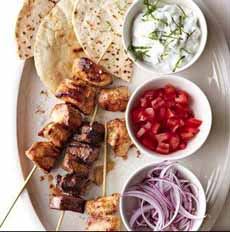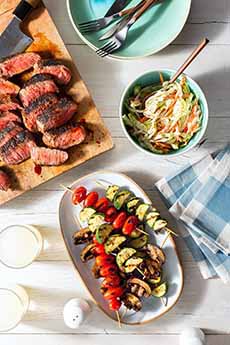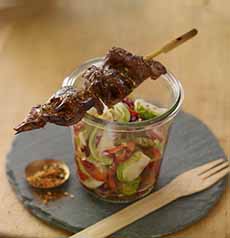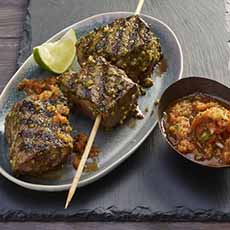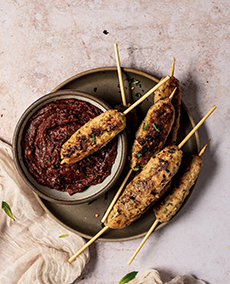Summer Souvlaki Recipe: Dips For Grilled Meat On Skewers
|
Souvlaki, which means “little skewer” in Greece, came to the U.S. with Greek immigrants and became a staple of street carts, Mediterranean restaurants, even diners. When you grill chunks of meat on skewers, you’re making souvlaki. Kebabs are the Arabic word for the same thing. The protein can be beef, chicken, lamb, pork, a plant-based protein (photo #5), or a combination. You can also use meatballs, sausages, and cubes of a firm fish (e.g. salmon, swordfish). If you prefer vegetables, those work, too (photo #2). Classic souvlaki serves the grilled skewers on a platter with salad or other vegetables, fries, pita bread, tzatziki (yogurt dip), and a wedge of lemon. A gyro is a Greek sandwich made not from skewered meat, but by thinly slicing meat from a large piece that’s grilled on a vertical rotisserie. The meat is wrapped in pita with tzatziki (in the Middle East hummus is used). Gyros are handheld street food, while souvlaki is typically plated. (Gyro means circular, referring to the rotisseried meat.) A kebap in Greece is different from the Turkish doner kebab. A Greek kofta kebap is spicy minced meat, mixed with parsley, onions, and garlic, formed into balls or a longer shape and grilled on a skewer. (We suggested Americanized meatballs, above, but you can make a kofta recipe.) You can serve the grilled skewers as snacks, appetizers (see photo #3), entrées, or as a base for sandwiches (photo #1). You can just slide the meat off the skewer into a piece of flatbread with a sauce, from Greek tzatziki to the numerous other flavorful sauce below. Here are tips and some modern sauce pairings for summer grilling, from Flavor & The Menu, a website for chefs that follows restaurant trends, for the idea. It starts with a few tips: FOR BEEF Use flank steak, strip steak, or top sirloin for: For the breast or thigh: For the belly, loin, or tenderloin: *This is a great use for herb stems that usually get thrown out. Toss them into the freezer. Of course, you can mix the different herbs in your soaking liquid. |
|
|
|
CHECK OUT WHAT’S HAPPENING ON OUR HOME PAGE, THENIBBLE.COM.
|
||
